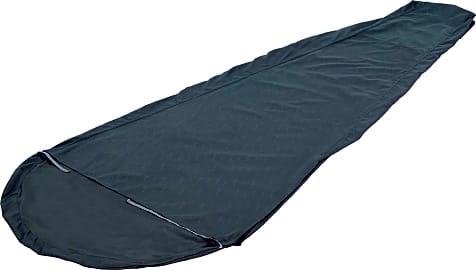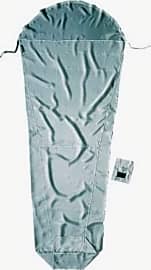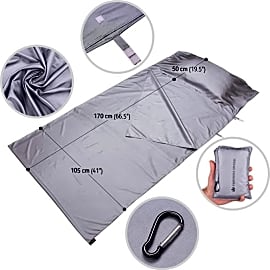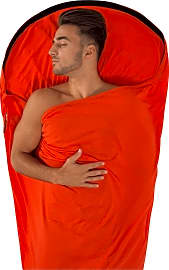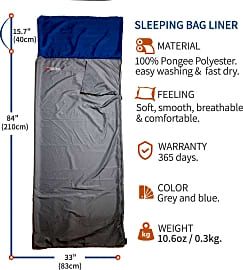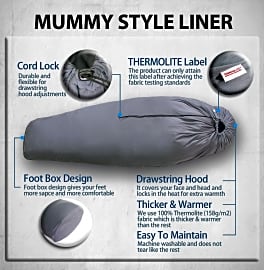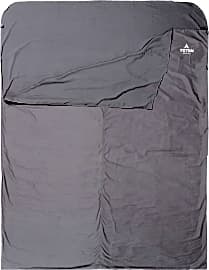The 10 Best Sleeping Bag Liners

This wiki has been updated 19 times since it was first published in September of 2020. Sleeping bag liners come in two basic shapes, mummy and rectangular, and both styles offer a variety of benefits to facilitate a good night's rest. They can provide additional warmth at night, help keep your sleeping bag clean, and protect you from environmental hazards, like insects. For many hikers, campers, and travelers, they're essential components for the journey. When users buy our independently chosen editorial picks, we may earn commissions to help fund the Wiki.
Editor's Notes
September 22, 2020:
Whether you're a serious mountaineer who is headed for the Andes or a first-time camper going to your local state park, our list includes options for all types of adventures. When making your choice, the most important factors to consider are its shape, material, and price.
If you have a mummy-style sleeping bag, you'll probably want a similar tapered design for your liner. Preferred by serious hikers, this shape cinches around the face and is generally warmer and lighter than a rectangular sheet. It's more versatile and can be used in any type of sleeping bag or on a bed in a hotel room. However, you won't be able to turn over very well inside the mummy-style liner - it turns with you instead. For some people, this feels a little claustrophobic.
Rectangular liners are also called sleep sacks and function more like sheets. They work well on their own and are a good choice for less-strenuous camping trips that don't involve backpacking. Travelers often prefer this shape to protect them from questionable bedding in hostels and budget hotels.
When it comes to materials, the most lightweight option is silk, like the Cocoon Silk Mummy. Silk is breathable in summer and warmer in winter, but it can often be expensive. For a much more affordable natural material, consider cotton, such as the Teton Sports. Cotton is strong and durable, but it's also bulky and heavy, which is not great for hiking.
Synthetic fabrics like microfiber and polyester are the most common, and their prices can vary greatly. The most comfortable synthetic materials are breathable, moisture-wicking, and slightly stretchy. Microfiber is usually a bit warmer at night than polyester, but it also tends to be a little heavier. Liners with both of these fabrics usually work well in hot and humid conditions, including the ALPS Mountaineering Microfiber, the Volcano Mountain, and The Friendly Swede. The Sea to Summit Insect Shield stands alone in this category because of its bug-repelling qualities and top-ranked comfort in steamy environments, both of which are highly desirable on a trip to the tropics.
When warmth is your top priority, there are two main options: fleece or insulated. Fleece adds up to 12 degrees Fahrenheit when used with a sleeping bag. Like the Coleman Stratus Fleece, they are cozy and soft, but often bulky and heavy. For wilderness backpackers who are heading into cold conditions, insulated options like the Litume Thermolite and the Therm-a-Rest Sleep Sack are ideal. They are quick-drying, lightweight, and expensive. And thanks to hollow fibers, they provide up to 25 degrees Fahrenheit of additional warmth when layered with a sleeping bag. We've also included the excellent Sea to Summit Reactor Extreme on our list, even though it looks a lot like the Sea to Summit Insect Shield. While their appearances are similar, they are designed for very different climates - and both at the top of their game.
No matter what kind of adventure you're planning, your quality of sleep will be one of the most important elements of your journey. If the rest of your gear needs an upgrade, you'll find that today's sleeping bags, cots, and camping hammocks are more comfortable than ever.
Special Honors
Tents-4-Homeless If you're upgrading to a new sleeping bag liner and your old one is still in good condition, consider donating it to Tents4Homeless. This non-profit organization distributes durable, lightweight tents and bedding to homeless men, women, and children who are not in emergency shelters. You'll find the donation form and shipping address on their website. tents4homeless.org


